| Solar eclipse of December 25, 2000 | |
|---|---|
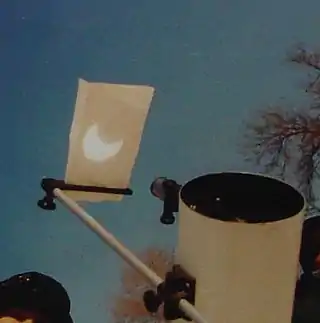 Projected partial eclipse from Minneapolis, Minnesota | |
 Map | |
| Type of eclipse | |
| Nature | Partial |
| Gamma | 1.1367 |
| Magnitude | 0.7228 |
| Maximum eclipse | |
| Coordinates | 66°18′N 74°06′W / 66.3°N 74.1°W |
| Times (UTC) | |
| Greatest eclipse | 17:35:57 |
| References | |
| Saros | 122 (57 of 70) |
| Catalog # (SE5000) | 9510 |
A partial solar eclipse occurred on December 25, 2000, also known as the "Christmas 2000 Solar Eclipse". A solar eclipse occurs when the Moon passes between Earth and the Sun, thereby totally or partly obscuring the image of the Sun for a viewer on Earth. A partial solar eclipse occurs in the polar regions of the Earth when the center of the Moon's shadow misses the Earth. It is also the last solar eclipse of the 20th century.
Christmas
This is the first Solar Eclipse on Christmas day since the annular solar eclipse of 1954.[1]
Images
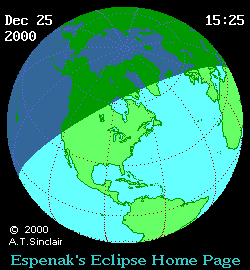
Animated path
Related eclipses
Eclipses of 2000
- A total lunar eclipse on January 21.
- A partial solar eclipse on February 5.
- A partial solar eclipse on July 1.
- A total lunar eclipse on July 16.
- A partial solar eclipse on July 31.
- A partial solar eclipse on December 25.
Solar eclipses 2000–2003
This eclipse is a member of a semester series. An eclipse in a semester series of solar eclipses repeats approximately every 177 days and 4 hours (a semester) at alternating nodes of the Moon's orbit.[2]
Partial solar eclipses on February 5, 2000 and July 31, 2000 occur in the previous lunar year set.
| Ascending node | Descending node | |||||
|---|---|---|---|---|---|---|
| Saros | Map | Gamma | Saros | Map | Gamma | |
| 117 | 2000 July 01 Partial (south) |
−1.28214 | 122 | 2000 December 25 Partial (north) |
1.13669 | |
127 Totality from Lusaka, Zambia |
2001 June 21 Total |
−0.57013 | 132 Partial from Minneapolis, MN |
2001 December 14 Annular |
0.40885 | |
137.jpg.webp) Partial from Los Angeles, CA |
2002 June 10 Annular |
0.19933 | 142 Totality from Woomera |
2002 December 04 Total |
−0.30204 | |
147 Culloden, Scotland |
2003 May 31 Annular |
0.99598 | 152 | 2003 November 23 Total |
−0.96381 | |
Metonic series
The metonic series repeats eclipses every 19 years (6939.69 days), lasting about 5 cycles. Eclipses occur in nearly the same calendar date. In addition, the octon subseries repeats 1/5 of that or every 3.8 years (1387.94 days). All eclipses in this table occur at the Moon's descending node.[3]
| Octon series with 21 events between May 21, 1993 and August 2, 2065 | ||||
|---|---|---|---|---|
| May 20–21 | March 8–9 | December 25–26 | October 13–14 | August 1–2 |
| 98 | 100 | 102 | 104 | 106 |
| May 21, 1955 | March 9, 1959 | December 26, 1962 | October 14, 1966 | August 2, 1970 |
| 108 | 110 | 112 | 114 | 116 |
| May 21, 1974 | March 9, 1978 | December 26, 1981 | October 14, 1985 | August 1, 1989 |
| 118 | 120 | 122 | 124 | 126 |
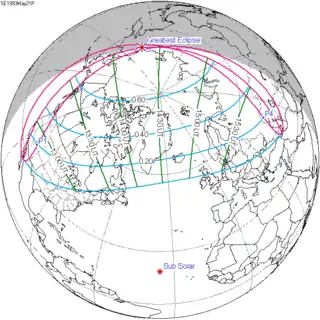 May 21, 1993 |
 March 9, 1997 |
 December 25, 2000 |
 October 14, 2004 |
 August 1, 2008 |
| 128 | 130 | 132 | 134 | 136 |
 May 20, 2012 |
 March 9, 2016 |
 December 26, 2019 |
 October 14, 2023 |
 August 2, 2027 |
| 138 | 140 | 142 | 144 | 146 |
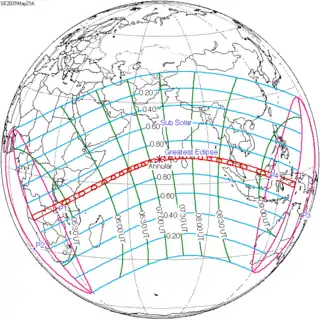 May 21, 2031 |
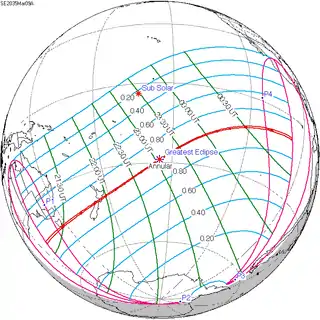 March 9, 2035 |
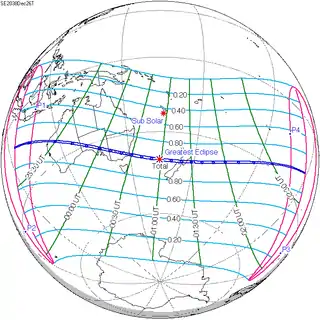 December 26, 2038 |
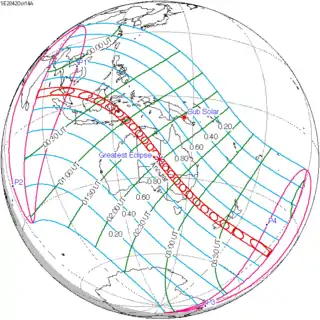 October 14, 2042 |
 August 2, 2046 |
| 148 | 150 | 152 | 154 | 156 |
 May 20, 2050 |
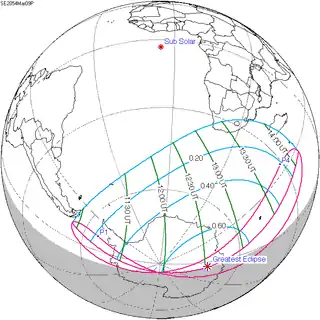 March 9, 2054 |
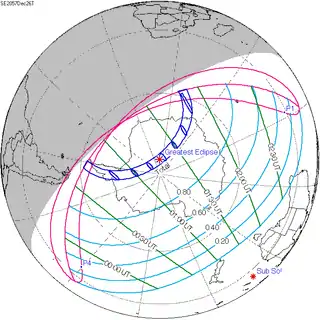 December 26, 2057 |
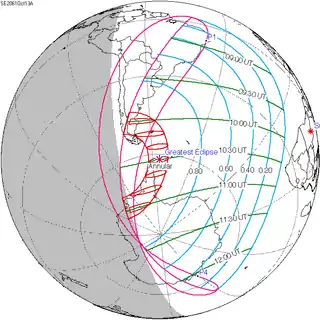 October 13, 2061 |
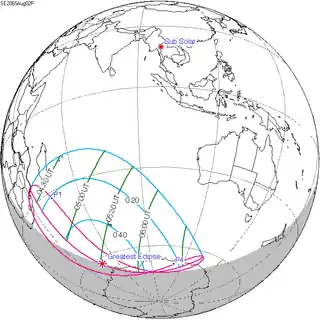 August 2, 2065 |
| 158 | 160 | 162 | 164 | 166 |
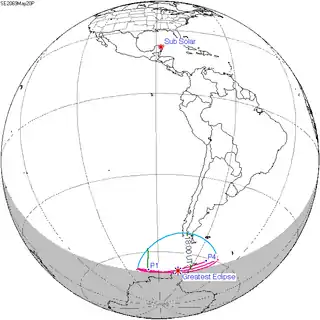 May 20, 2069 |
March 8, 2073 | December 26, 2076 | October 13, 2080 | August 1, 2084 |
References
- ↑ Espenak, Fred. "Partial Solar Eclipse of December 25, 2000". eclipse.gsfc.nasa.gov. NASA. Retrieved November 12, 2023.
- ↑ van Gent, R.H. "Solar- and Lunar-Eclipse Predictions from Antiquity to the Present". A Catalogue of Eclipse Cycles. Utrecht University. Retrieved October 6, 2018.
- ↑ Note S1: Eclipses & Predictions in Freeth, Tony (2014). "Eclipse Prediction on the Ancient Greek Astronomical Calculating Machine Known as the Antikythera Mechanism". PLOS ONE. 9 (7): e103275. Bibcode:2014PLoSO...9j3275F. doi:10.1371/journal.pone.0103275. PMC 4116162. PMID 25075747.
External links
- Earth visibility chart and eclipse statistics Eclipse Predictions by Fred Espenak, NASA/GSFC
.jpg.webp)

